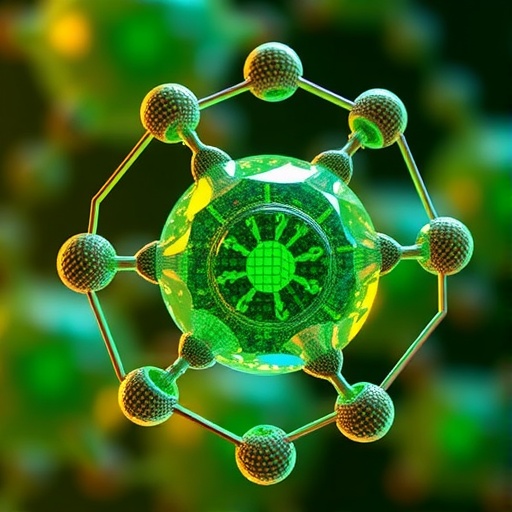In a groundbreaking study published in “Waste Biomass Valor,” researchers have unveiled a novel approach to synthesizing metallic nanoparticles by utilizing waste biomass. This sustainable method not only addresses waste management issues but also paves the way for the development of environmentally friendly materials with diverse applications. The research, led by Kiran N.S., Paliwal H., and Yashaswini C., sheds light on the potential of biogenic processes in the rapidly evolving field of nanotechnology.
The increasing demand for metallic nanoparticles, known for their unique physical and chemical properties, has prompted scientists to explore greener alternatives to traditional synthesis methods that often involve hazardous chemicals. Through intensive research, the team has demonstrated that waste biomass—such as agricultural residues, food waste, and other organic materials—can serve as effective reducing agents in the production of metallic nanoparticles. This shift not only enhances sustainability but also significantly reduces costs associated with nanoparticle synthesis.
Central to the study is the green synthesis approach that leverages biological processes for nanoparticle formation. The researchers meticulously explored various waste biomasses, discovering that each type offers unique advantages. For instance, agricultural waste appears rich in phytochemicals that facilitate the reduction of metal ions to their nanoparticle forms. This evidence underscores the importance of selecting appropriate biomass sources to maximize the efficiency of the synthesis process.
Characterization of the produced nanoparticles is equally vital. The researchers employed a combination of techniques, including UV-Vis spectroscopy, transmission electron microscopy (TEM), and X-ray diffraction (XRD), to analyze the size, shape, and crystalline structures of the nanoparticles. These sophisticated characterization techniques confirmed the successful synthesis of nanoparticles with desired properties, which are crucial for their intended applications in various fields such as medicine, electronics, and environmental remediation.
The multifunctional applications of the synthesized metallic nanoparticles are particularly noteworthy. With inherent antibacterial properties, these nanoparticles hold significant promise in the healthcare sector, offering innovative solutions for infection control. Moreover, their application in drug delivery systems could lead to more effective treatment protocols with minimized side effects. The synergy between waste-derived nanoparticles and biomedical applications symbolizes a dual advantage—addressing health issues while promoting waste valorization.
In addition to healthcare, the environmental implications of utilizing waste biomass to produce metallic nanoparticles cannot be overstated. The researchers illustrated that these nanoparticles can be applied in water treatment processes, where their ability to adsorb and degrade pollutants showcases their potential as eco-friendly alternatives to conventional purification techniques. This kind of application emphasizes the transformative role that nanotechnology can play in enhancing environmental sustainability.
The study also highlighted the economic advantages of biogenic metallic nanoparticles. By utilizing waste materials that would otherwise contribute to landfill overflow, industries can significantly reduce raw material costs. This aligns with global sustainability goals, fostering a circular economy where waste is no longer considered a problem but rather a resource. Furthermore, the green synthesis process presents an attractive business model for startups and established companies aiming to innovate while minimizing environmental impact.
Looking towards the future, the researchers advocate for further exploration into the scalability of this green synthesis approach. While laboratory results are promising, translating this into industrial-scale production remains a challenge that requires additional research and investment. Collaboration between academia and industry will be essential to solve the technical hurdles involved in scaling up these processes effectively without compromising the quality of the metallic nanoparticles produced.
Public awareness regarding the benefits of biogenic approaches in nanotechnology is also critical for broader acceptance of these materials. Increased engagement with the general populace via educational programs and outreach can foster understanding and support for sustainable practices. As the demand for greener technologies continues to rise, the study’s findings may serve as a catalyst for similar research endeavors, inspiring others to seek innovative solutions through the use of natural resources.
The implications of implementing biogenic metallic nanoparticles go beyond mere novelty; they represent a seismic shift towards a more sustainable and environmentally responsible industry. By embracing waste biomass as a resource for high-value nanomaterials, we stand on the verge of a new era in materials science. These findings have the potential to influence policy-making, encouraging sectors to adopt greener practices, which could lead to a significant reduction in the carbon footprint associated with nanomaterials production.
In conclusion, the research conducted by Kiran N.S., Paliwal H., and Yashaswini C. sets a precedent in the field of green nanotechnology, redefining our approach to materials synthesis. The innovative use of waste biomass not only highlights an environmentally-friendly method of production but also showcases the multifaceted applications of biogenic metallic nanoparticles. As the world grapples with environmental challenges, this research provides a beacon of hope that harnessing natural processes can lead us toward sustainability and technological advancement without compromising the planet’s health.
Understanding the intricate balance between human innovation and environmental protection is paramount as we progress further into the 21st century. This study enriches our understanding of how waste valorization can serve as a foundational principle for future advancements in various industries. With continued research, collaboration, and advocacy, the long-term benefits of biogenic metallic nanoparticles could reshape the landscape of manufacturing and materials science forever.
Subject of Research: Biogenic Synthesis of Metallic Nanoparticles from Waste Biomass
Article Title: Biogenic Metallic Nanoparticles from Waste Biomass: Advances in Green Synthesis, Characterization, and Multifunctional Applications
Article References:
Kiran, N.S., Paliwal, H., Yashaswini, C. et al. Biogenic Metallic Nanoparticles from Waste Biomass: Advances in Green Synthesis, Characterization, and Multifunctional Applications.
Waste Biomass Valor (2025). https://doi.org/10.1007/s12649-025-03280-6
Image Credits: AI Generated
DOI: 10.1007/s12649-025-03280-6
Keywords: biogenic nanoparticles, waste biomass, green synthesis, environmental sustainability, multifunctional applications, nanotechnology




